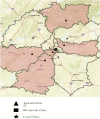Impact of Availability of Telehealth Programs on Documented HIV Viral Suppression: A Cluster-Randomized Program Evaluation in the Veterans Health Administration
- PMID: 31211155
- PMCID: PMC6559276
- DOI: 10.1093/ofid/ofz206
Impact of Availability of Telehealth Programs on Documented HIV Viral Suppression: A Cluster-Randomized Program Evaluation in the Veterans Health Administration
Abstract
Background: Telehealth may improve care for people with HIV who live far from HIV specialty clinics. We conducted a cluster-randomized evaluation to determine the impact of availability of HIV telehealth programs on documented viral suppression in Veterans Administration clinics.
Methods: In 2015-2016, people who previously traveled to HIV specialty clinics were offered telehealth visits in nearby primary care clinics. Patients were cluster-randomized to immediate telehealth availability (n = 925 patients in service areas of 13 primary care clinics offering telehealth) or availability 1 year later (n = 745 patients in 12 clinics). Measures during the evaluation year included telehealth use among patients in areas where telehealth was available and documented HIV viral suppression (viral load performed and <200 copies/mL). Impact of telehealth availability was determined using intention-to-treat (ITT) analyses that compared outcomes for patients in areas where telehealth was available with outcomes for patients where telehealth was not available, regardless of telehealth use. Complier average causal effects (CACEs) compared outcomes for telehealth users with outcomes for control patients with equal propensity to use telehealth, when available.
Results: Overall, 120 (13.0%) patients utilized telehealth when it was available. Availability of telehealth programs led to small improvements in viral suppression in ITT analyses (78.3% vs 74.1%; relative risk [RR], 1.06; 95% confidence interval [CI], 1.01 to 1.11) and large improvements among telehealth users in CACE analyses (91.5% vs 80.0%; RR, 1.14; 95% CI, 1.01 to 1.30).
Conclusions: Availability of telehealth programs improved documented viral suppression. HIV clinics should offer telehealth visits for patients facing travel burdens.
Keywords: HIV; randomized trial; telehealth; veterans.
Figures


Similar articles
-
Geographic access and use of infectious diseases specialty and general primary care services by veterans with HIV infection: implications for telehealth and shared care programs.J Rural Health. 2014 Fall;30(4):412-21. doi: 10.1111/jrh.12070. Epub 2014 Apr 6. J Rural Health. 2014. PMID: 24702698
-
Telehealth Services Designed for Women: An Evidence Map [Internet].Washington (DC): Department of Veterans Affairs (US); 2017 Nov. Washington (DC): Department of Veterans Affairs (US); 2017 Nov. PMID: 30383345 Free Books & Documents. Review.
-
Effectiveness of a combination strategy for linkage and retention in adult HIV care in Swaziland: The Link4Health cluster randomized trial.PLoS Med. 2017 Nov 7;14(11):e1002420. doi: 10.1371/journal.pmed.1002420. eCollection 2017 Nov. PLoS Med. 2017. PMID: 29112963 Free PMC article. Clinical Trial.
-
Mixed-methods evaluation of a telehealth collaborative care program for persons with HIV infection in a rural setting.J Gen Intern Med. 2013 Sep;28(9):1165-73. doi: 10.1007/s11606-013-2385-5. Epub 2013 Mar 9. J Gen Intern Med. 2013. PMID: 23475640 Free PMC article.
-
Evidence Brief: The Quality of Care Provided by Advanced Practice Nurses.2014 Sep. In: VA Evidence Synthesis Program Evidence Briefs [Internet]. Washington (DC): Department of Veterans Affairs (US); 2011–. 2014 Sep. In: VA Evidence Synthesis Program Evidence Briefs [Internet]. Washington (DC): Department of Veterans Affairs (US); 2011–. PMID: 27606392 Free Books & Documents. Review.
Cited by 11 articles
-
Efficacy of a Telehealth Delivered Couples' HIV Counseling and Testing (CHTC) Intervention to Improve Formation and Adherence to Safer Sexual Agreements Among Male Couples in the US: Results from a Randomized Control Trial.AIDS Behav. 2022 Feb 22:1-12. doi: 10.1007/s10461-022-03619-3. Online ahead of print. AIDS Behav. 2022. PMID: 35194698 Free PMC article.
-
Supporting Retention in HIV Care: Comparing In-Person and Telehealth Visits in a Chicago-Based Infectious Disease Clinic.AIDS Behav. 2022 Feb 3:1-7. doi: 10.1007/s10461-022-03604-w. Online ahead of print. AIDS Behav. 2022. PMID: 35113267 Free PMC article.
-
Experiences with Telemedicine for HIV Care During the COVID-19 Pandemic: A Mixed-Methods Study.AIDS Behav. 2022 Jan 22:1-13. doi: 10.1007/s10461-021-03556-7. Online ahead of print. AIDS Behav. 2022. PMID: 35064390 Free PMC article.
-
HIV care using differentiated service delivery during the COVID-19 pandemic: a nationwide cohort study in the US Department of Veterans Affairs.J Int AIDS Soc. 2021 Oct;24 Suppl 6(Suppl 6):e25810. doi: 10.1002/jia2.25810. J Int AIDS Soc. 2021. PMID: 34713585 Free PMC article.
-
Telepharmacy: A Potential Alternative Approach for Diabetic Patients During the COVID-19 Pandemic.J Multidiscip Healthc. 2021 Aug 20;14:2261-2273. doi: 10.2147/JMDH.S325645. eCollection 2021. J Multidiscip Healthc. 2021. PMID: 34447253 Free PMC article. Review.
LinkOut - more resources
Full Text Sources

